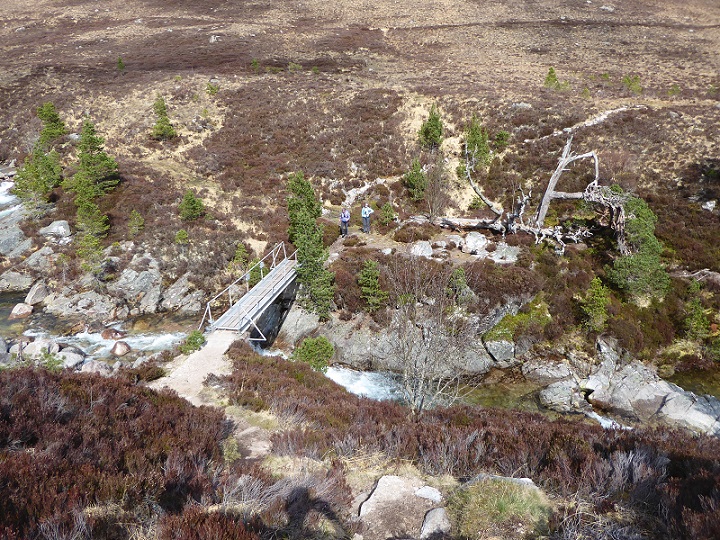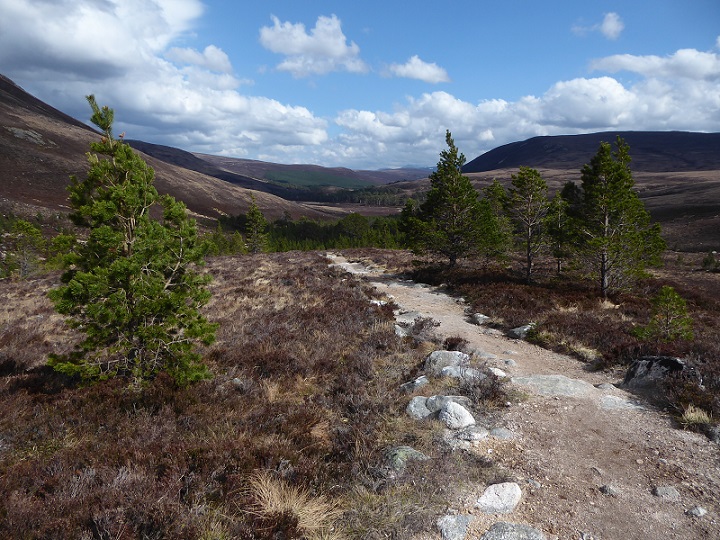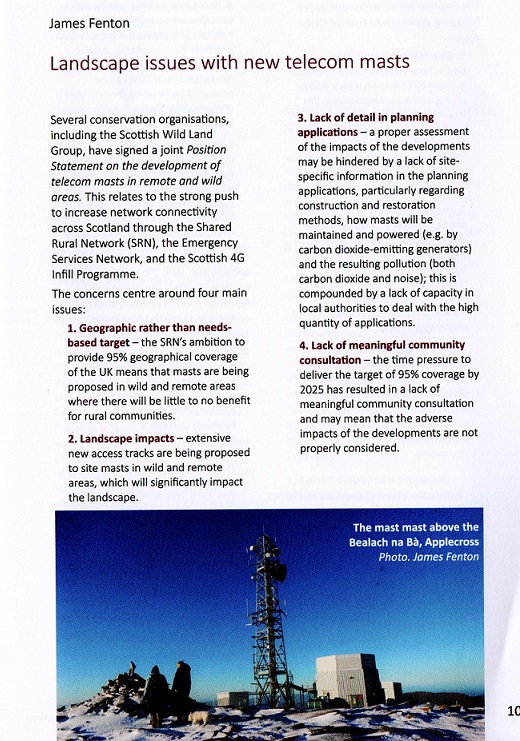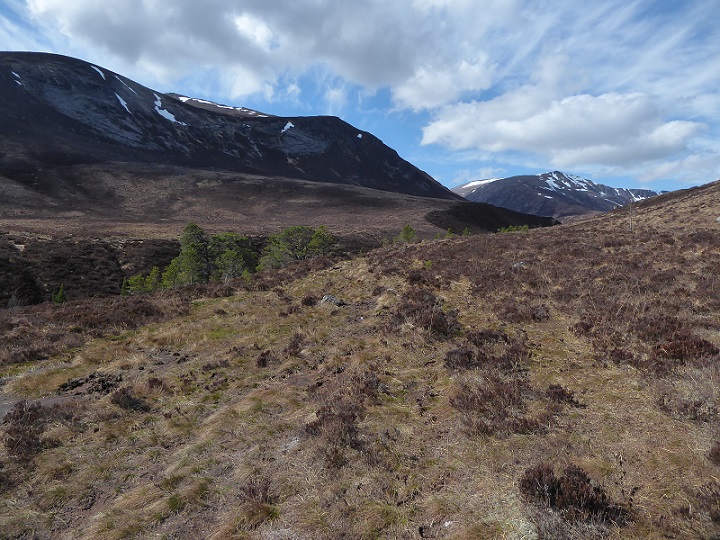
The Luibeg mast planning application
Yesterday the planning application for the proposed telecommunications mast above the Luibeg bridge on the Mar Lodge estate (see here) was temporarily withdrawn by the developer “in light of recent consultation responses received“. The application was rapidly developing into a test case for plans to erect similar masts (with access tracks and diesel generators) throughout Scotland as part of the UK Government’s “Shared Rural Network Roll-out”, an ill-thought out policy to provide mobile phone coverage over 95% of the British Isles.
The Cairngorms National Park Authority (CNPA) has once again decided to withdraw almost all the documentation associated with the planning application from its planning portal (see here). This, as I have explained before (see here), plays into the hands of developers and the very rich. Where people have made the effort to expose ill-thought out applications the very least they deserve is all the information remains in the public realm. There is no legal requirement for our Planning Authorities to expunge documents from the public record in this way but still they do so.
Unfortunately, I had not had time to download the documents submitted by the applicant, a company called WHP telecoms Ltd based in Northern Ireland, in support of the development. They were truly dreadful and the objections had started to expose them for what they were. (I will now make a Freedom of Information request for all the documents).
A taster was given on the application form – which is still on the planning portal – which described the site “as unutilised land within the National Park”. The whole point of designating Wild Land Areas is that this is land which is meant to be protected from development, not “utilised”.

Suffice to say at present that one of the arguments the developer had made for siting the mast above the Luibeg Bridge was it would help communications for local farmers. Either WHP telecoms Ltd had not visited the site – they appear to be under time pressure to meet UK Government targets – or they had had their eyes shut because the area is now covered with naturally regenerating Caledonian Pine Forest. Their withdrawal letter makes it clear that they now intend to engage further to try and persuade people of the need for a mast in this location to address what they describe as “the market failure in this area”.
Telecommunications, markets and wild land
By coincidence, Wild Land News also arrived in my letterbox yesterday. It contains an excellent summary by James Fenton of the landscape issues created by the drive to increase mobile coverage across Scotland:

Note that this drive to increase mobile coverage does not just come from the UK Government, it is also being pushed by the Scottish Government (the 4G infill programme).
James Fenton’s article also summarises the position statement (see here), developed by a range of organisations concerned about the impact of such masts on Wild Land. This sets out an alternative approach for mast, based not on achieving 95% geographical coverage across the UK, but on siting masts where they are needed by local communities. In my view it is essential reading for anyone who is concerned about what is happening and provides a well-thought out solution.
As far as I am aware neither of National Park Authority Boards, which could be giving a lead on this, have so far considered the position statement, let alone adopted it. Instead the main focus of their staff is to process planning applications, including those which raise fundamental issues which go to the core about what the National Park should be about, according to the targets set by the Scottish Government. The withdrawal letter from the WHP telecoms Ltd thanks CNPA staff “for keeping us informed about the upcoming committee meeting where the scheme was to be discussed”. Having set the committee date in this way, there was no way CNPA staff could have given proper consideration to the issues raised by this application.
The wording of the withdrawal letter raises a much wider issue, however, and that is our National Park Authorities need to address and that the marketisation of land across Scotland, which will end up treating both wild land and landscape as a commodity. The current issue of Wild Land News (see here) has excellent coverage of the implications of the renewed push for windfarms and associated energy infrastructure such as pump storage schemes. While our National Parks offer some protection against that at present, because there is a policy presumption against new windfarms, within their boundaries, they are not protected against most of the associated infrastructure like powerlines. However, set the drive for wind energy alongside the land grab being driven by the UK and Scottish Governments attempts to create a carbon offsetting market (through peatland restoration, tree planting and commodifying nature) and the landscape in our National Parks is under threat as never before.

The erection of telecommunications masts are thus one small part of a much wider drive to marketise land in Scotland.
The proposed Luibeg mast provides an excellent illustration of the ill-thought out policy guddle. It would be on land where the Caledonian Forest and peat bog is now regenerating as a result of National Trust for Scotland reducing deer numbers on this part of the Mar Lodge Estate to under two per square kilometre. This is good for nature and helps absorb carbon from the atmosphere and has been achieved for very little cost. By contrast the proposed mast would be powered by a diesel generator, which will pump carbon and pollution out into atmosphere, sited on hardstanding and would require to be serviced by a new access track. The papers that have now been withdrawn by the CNPA planning portal contained no assessment of the impact this would have on peatland and the regenerating woodland.
Unfortunately, the Scottish Government’s consultation on proposals to reform our National Parks (see here) contains nothing that would help prevent inappropriate developments such as this; it has no proposals to make the planning authorities in our National Parks different to elsewhere and nothing that would help prevent the marketisation of wild land. I will come back to that in another post but at present the Scottish Government is a key part of the problem.

You said it, Nick: “… at present the Scottish Government is a key part of the problem.” In ten years time there will be virtually no place in Scotland that hasn’t been denatured in some way because of ill-thought out policies, poorly informed – I am kind – decisions and a blinkered refusal to look at the bigger picture. Tunnel vision and greenbacks rule, no pun intended.
It would be great to see all of the objections that were recieved during the first application. I know my one did not reach the list and I know of others that carried very valid points that were also not posted before the list was taken down. Seeing this would ensure that we cover all aspects without gaps in points of concern during any future applications.
It would seem the Cairngorms are just the start. A new application has been submitted for a mast in Glen Affric. As with the Cairngorms mast, it’s difficult to see who will significantly benefit from its coverage. Application:
https://wam.highland.gov.uk/wam/applicationDetails.do?activeTab=documents&keyVal=S1R06EIHMXZ00
It get worse; now one at the famous wild camping spot at the head of Loch Mullardoch: Highland 23/04105/TNPNO